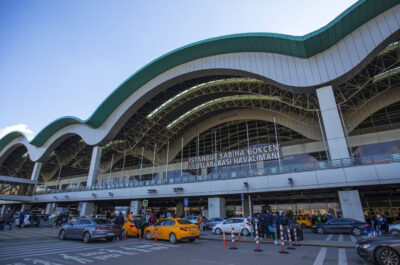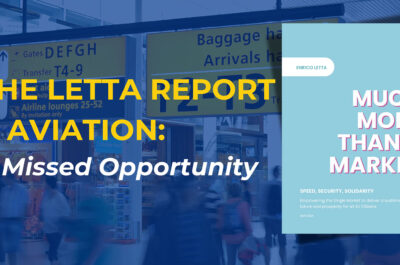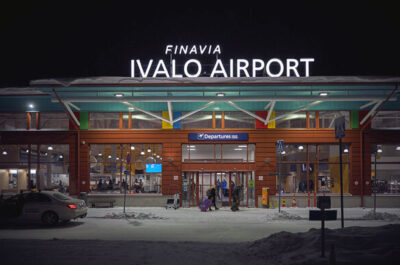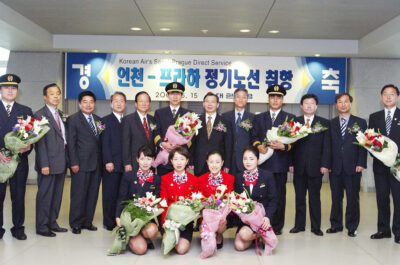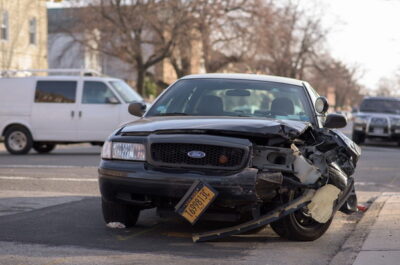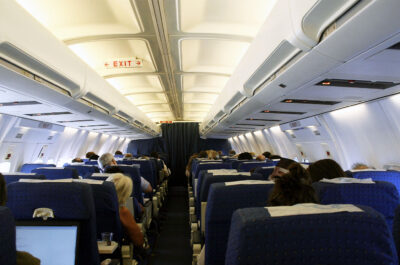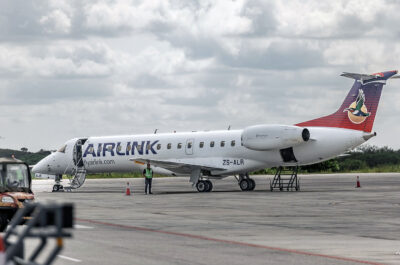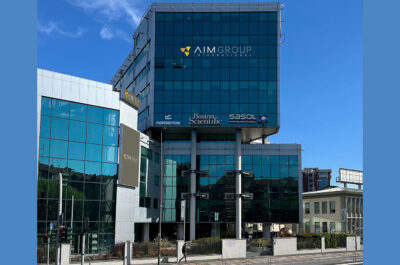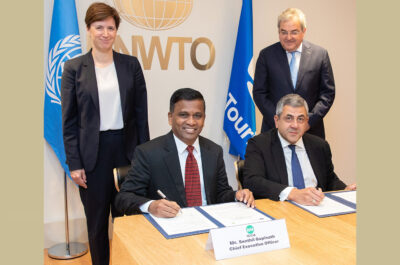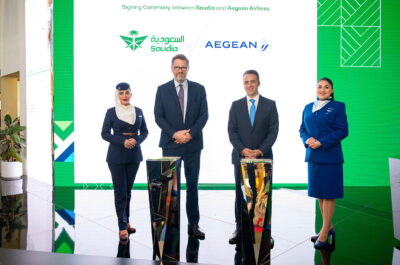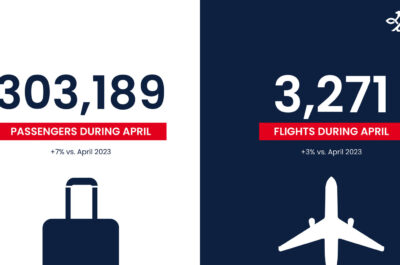The airport industry welcomes the adoption by the European Commission of a new strategy for European aviation. This strategy in based on a long-term vision for the air transport sector, with a primary focus on improved connectivity, enhanced competitiveness and effective sustainability.
BRUSSELS – The EU Commission’s long-awaited ‘Aviation Package’, published yesterday, sends a positive signal by stressing that aviation is a “key enabler” of economic growth, job generation, and connectivity. Together with the proposed new regulatory framework for Drones and the revision of EASA’s Basic Regulation, this is an important step forward. However, the ‘strategy’ itself remains short of ambition and lacks concrete measures on the ‘Social Dimension’ of air transport. Some proposals in the new EASA Regulation may even encourage social dumping and entail a lowering of social standards in aviation.
Commenting on the adoption of the Package, ECA President Dirk Polloczek says: “The Commission brings forward crucial proposals and clearly acknowledges the strategic value of aviation in Europe. This is good! But on a number of issues, we need to go further than describing what we already know. In particular, after years of consultations, it is time to make the – so far disregarded – Social Dimension an integral part of aviation policy. The Aviation Package clearly fails to do that and is highly disappointing in that respect.”
Last June, at the Conference ‘A Social Agenda for Transport’, stakeholders sent a strong message to the Commission that concrete action is required on ‘atypical employment forms’, social dumping and ‘flags of convenience’. “Given the limited take-up of these issues in the strategy, strengthening the social pillar will remain among ECA’s top priorities in 2016,” adds Polloczek.
Launching the revision of EASA’s Basic Regulation is a key step, as better safety management is indispensable to prevent accidents in a rapidly growing market.
“The proposed ‘pooling’ of national safety oversight capacities is very welcomed and the mechanisms to deal with weak or ‘failing’ national oversight authorities are an absolute must,” says Philip von Schoppenthau, ECA Secretary General. “However, the proposal to create a European ‘EASA AOC’ is premature and cannot be considered before all legal and social repercussions have been addressed”. Also highly problematic is the proposal to do away with the system whereby the Member States approve intra-European wet-leasing in their country. Such a move would reduce their ability to effectively oversee the safety of these operations. “The same ‘red card’ is due for the ill-considered proposal to allow foreign pilots to fly EU-registered aircraft without fully complying with EASA FCL requirements. This can have serious safety repercussions and would open the door for social dumping,” von Schoppenthau adds.
“Drones represent a sector with a significant growth potential. However, unless integrated into the European airspace in a safe manner, they can carry hazards both to manned aviation and the people on the ground. “If the EU wants to stimulate this growth potential, their underestimated risk of low-level operations, as well as issues like registration of drones or auto-avoidance systems must be considered,” says Dirk Polloczek.
“On all these issues we are ready and keen to actively contribute to the upcoming co-decision procedure and to further work with the Commission to find solutions that are both safe and socially responsible,” Polloczek adds.
Europe’s airports welcome Bulc’s new aviation strategy
The airport industry welcomes the adoption by the European Commission of a new strategy for European aviation. This strategy in based on a long-term vision for the air transport sector, with a primary focus on improved connectivity, enhanced competitiveness and effective sustainability. It includes a set of actions aimed at opening up access to key external markets and addressing capacity problems in the air and at airports, all while maintaining the highest levels of safety and security.
Olivier Jankovec, Director General of ACI Europe said “The Commission has gotten it right – taking stock of the increasing strategic relevance of air connectivity for our economy. What it has put on the table today is a commendably pragmatic approach – one that recognises aviation growth as a key enabler of the EU’s wider growth and jobs agenda.”
Consumers & Open Skies
With this new aviation strategy, the Commission is also moving towards a less airline-centric and more consumer-centric aviation policy. In this regard, ACI EUROPE fully supports the ambitious plan to negotiate aviation agreements* with the EU’s main trading partners to secure additional market access opportunities under conditions ensuring fair competition.
Jankovec commented “We need more open skies agreements beyond Europe. This is essential for airports to attract more air services, develop their route network and improve the connectivity of the communities they serve. Ultimately, this is also about avoiding the marginalisation of Europe and supporting its global hub positioning. Closing markets and resisting change has never been a successful business strategy – and it rarely does any good for consumers.”
Airport Capacity & SES
While Europe’s airports support the on-going efforts of the Commission to tackle congestion and capacity constraints both in the air and on the ground, ACI Europe noted that decisive action on these issues rests with Member States.
In this regard, Europe’s airports share the frustrations of their airline partners over the lack of progress in the implementation of the Single European Sky. They are also deeply concerned by the lack of proper long-term national strategies to address the looming airport capacity crunch. While Europe’s airports are still waiting for the adoption by the Council of Transport Ministers of a revised Slot Regulation, this can only be a short-term fix – as it is about managing congestion, not addressing it.
Therefore, ACI Europe calls on the Commission to develop a more ambitious EU strategy on airport capacity – including the adoption of airport capacity targets for Europe aligned with the Single European Sky.
Airport Charges & Competition
ACI Europe also notes that the Commission has resisted calls by some airlines° for even tighter regulation of airport charges. The Commission will rather focus on the implementation of the current EU Directive on airport charges and will assess at a later stage whether a review is needed.
ACI Europe stands ready to assist the Commission in this task. Changing market conditions, in particular increasing airport competition, may require a lighter and more tailored regulatory approach.
Jankovec said “The EU Directive on airport charges is essentially based on the unquestioned premise that airports are monopolies. That is no longer the case. The Commission has already acknowledged that airports compete in the State aid guidelines it adopted last year? – which actually restrict the public financing of airports because of effective and growing competition among them. It will have to acknowledge the same for airport charges. This is about coherent policy alignment.”
Safety & Security
Finally, ACI Europe also stresses the need for keeping regulatory driven costs in check – especially as regards safety and security. This is an essential part of improving European aviation’s competitive position. Accordingly, Europe’s airports support the move of EASA towards a performance-based approach to aviation safety, as well as increased efficiency through better integration between the agency and Member States. But ACI EUROPE reaffirms its opposition for now, to EASA’s extension of competences in the fields of security and the environment.
Jankovec added “On security, the Commission needs to push for real progress towards a truly risk-based system across the board. We need to move from systematic and undifferentiated security checks at airports towards more targeted security checks that focus our resources where the risk is. This means not relying only on technology – which will take time to develop – but increasingly on effective sharing of intelligence and data. This is the only way to deliver both security and cost efficiencies. We urge the Commission to look at how we could introduce in Europe a pre-check system similar to the one successfully deployed by the US TSA at more than 150 airports.”
ERA calls for stronger action to deliver an aviation strategy for Europe
The European Regions Airline Association (ERA) welcomes the EC’s recognition that aviation is a key driver of economic growth, jobs, trade and mobility and that a strategic review of the sector is needed to ensure that European aviation maintains its leadership of this global market. A strong and successful aviation sector is vital to EU citizens and to ERA’s members who provide connectivity to some of Europe’s most remote regions where air transport is an essential mode of transport.
Some of the strategy’s proposals are positive and will lead to a stronger (and safer) industry. The EC has identified the key issues that need to be tackled – many of which were in ERA’s own strategy released at the beginning of this year (The Future of Regional Aviation). However, many of the actions proposed in the EC’s strategy are short term, have no distinct timelines and do not provide a strong and clear action plan to strengthen Europe’s aviation industry.
Overall, ERA believes that the strategy will not increase the long-term competitiveness of the industry compared to other methods of transport and non-European competitors. However, ERA is ready to work with the EC, Council and Parliament to ensure that the strategy is modified to deliver on its original intent – a stronger, fitter and more efficient air transport system.
Simon McNamara, Director General of ERA, says: “We are pleased that the strategy recognises that aviation is a driver of economic growth, jobs, trade and mobility and that a strategic review of the sector is needed to ensure that European aviation remains competitive and maintains its leadership in a global market. However, many of the strategy’s action points lack substance and will not tackle some of the underlying weaknesses of the industry. For example, the imminent lack of hub airport capacity in Europe threatens ERA’s members’ access to Europe’s largest airports and risks a loss of connectivity to Europe’s regions.
“Investment in aviation is also critical, whether through new infrastructure, aircraft, systems or people. This needs to be driven by access to funding through channels, including the European Investment Bank, with a greater recognition of aviation’s role as a social and economic enabler for Europe and its citizens.
“The strategy is a step forward, but it needs more work to deliver on its intent and ERA is looking forward to working with the EC, Council and Parliament to strengthen the plan.”
On some of the specific issues addressed in the strategy ERA has the following initial reaction:
Safety & security
ERA welcomes the moves to reform the European Aviation Safety Agency (EASA) and its basic regulation with a stronger focus on delivering risk and performance-based regulation. A strengthened, more effective, EASA should lead to the reduction of the need for national safety authorities. Equally, ERA applauds the proposals to expand the safety regulatory oversight of drones, an issue the association called for in August this year. With regards to aviation security, it is vital that states take leadership and protect their citizens by committing to funding both new and existing anti-terrorist security measures.
Investment
Investment in aviation is essential. The strategy mentions the significant overall economic impact of aviation on the EU’s GDP – as much as €510bn. Far greater use of organisations, such as the European Investment Bank (EIB), should be explored to enable greater investment in new infrastructure, aircraft, systems and people – currently it is limited to mainly air traffic management-related projects. ERA is already in discussions with the EIB, calling for an expansion of its aviation-related activities. ERA also welcomes the proposed relaxation of ownership and control rules for airlines.
Tackling monopolies
The provision of air traffic services is still undertaken on a monopoly basis. Reform is not coming quickly enough to this industry and, regrettably, the Single European Sky project has not led to the radical efficiency shift that is needed. Some airports are operated as monopolies and the existing regulatory regime, particularly with regards to airport charges, does not provide the necessary control or deliver sufficient transparency over their activities. A more concrete set of regulatory actions and economic regulations are needed to reduce the cost of these monopolies to EU citizens and air carriers than has been proposed in the strategy.
Infrastructure – airports
Europe’s key hub airports are already congested and the strategy identifies the physical and economic costs of the lack of new runway and terminal capacity. Often regional, smaller aircraft operations are the first to be squeezed out of congested hub airports leading to a loss of connectivity for citizens. Despite recognising the problem, the EC’s strategy does not propose any significant measures to address this challenge other than ‘optimising’ what already exists. A European plan to expand and increase runway and terminal capacity in the long term, alongside a plan to fund this expansion, is essential.
Connectivity
ERA’s members serve the parts of Europe where air transport is vital. The value of regional connectivity is recognised in the strategy which is welcome news. However, other than a means of monitoring connectivity, the EC proposes no substantive action to promote and encourage air connectivity, especially to the regions.
Support to regional operations
The strategy recognises tools such as the Public Service Obligation (PSO) system as a means of encouraging regional operations. However, other than issuing guidelines on the current EU rules, there are no proposals to encourage their greater and more efficient use or means of ensuring that air transport serves parts of Europe where it may not be economically viable to do so, but where there is a real social need.
Regulatory complexity and taxation
The strategy makes little mention of the overall regulatory burden placed on aviation, and does not take into account the published studies that illustrate the detrimental impact of the numerous aviation-specific taxes and charges (including the intra-European scope of the EU ETS) on European jobs, competitiveness and the economy. Although the strategy acknowledges that aviation specific taxes and levies negatively impact connectivity and competitiveness, there is no clear plan to achieve their removal. There needs to be a thorough analysis of the regulatory framework in place and clear plans to remove unnecessary regulation and complex and disproportionate taxes that are often not consistent with the International Civil Aviation Organisation policies and consolidated international agreements.
Europe’s airspace users’ associations call for more concrete measures
The European airspace user associations (AEA, EBAA, EEA, ELFAA, ERA and IACA*) welcome the European Commission’s initiative to develop and implement an “Aviation Strategy for Europe”. The associations contributed to this exercise by responding to the public consultation, drafting position papers and holding face-to-face meetings with EU regulators, in the expectation that the strategy would address the challenges that the EU’s aviation sector is currently facing.
The long-awaited strategy, which was presented earlier today, is the result of a year’s work by the Commission. To its credit, the Commission openly acknowledges that aviation is a key driver of economic growth, jobs, trade mobility and connectivity. However, the strategy lacks ambition and does not propose adequate measures to bolster the competitiveness of air operators – a vital sector in Europe.
In a joint reaction to the strategy, the associations welcome the deserved focus on the indispensable contribution of aviation to Europe’s economy and mobility but stress that there is an urgent need for the Commission to now propose more specific and far-reaching remedies. “While the strategy review correctly identifies some of the significant challenges that Europe’s aviation sector is currently facing in terms of the cost and provision of infrastructure (both on the ground and in the air), the integrity of the market, inefficiencies in the value chain and a burdensome regulatory framework (e.g. national and local aviation taxes, the intra-EU ETS), it stops short of proposing concrete measures to address these.”
The associations will further engage with the Commission and the European decision makers to request immediate actions. The European air operators’ associations AEA, EBAA, EEA, ELFAA, ERA and IACA unanimously conclude that “addressing these issues is of crucial importance in order to ensure that aviation becomes a priority sector in Europe. The associations and their members stand ready to assist with the urgently required follow-up work.”
*: AEA (Association of European Airlines), EBAA (European Business Aviation Association), EEA (European Express Association) ELFAA (European Low Fares Airline Association), ERA (European Regions Airline Association), IACA (International Air Carrier Association).
The European Parliament Resolution on Aviation Package – Nov 2015
Vicky is the co-founder of TravelDailyNews Media Network where she is the Editor-in Chief. She is also responsible for the daily operation and the financial policy. She holds a Bachelor's degree in Tourism Business Administration from the Technical University of Athens and a Master in Business Administration (MBA) from the University of Wales.
She has many years of both academic and industrial experience within the travel industry. She has written/edited numerous articles in various tourism magazines.














